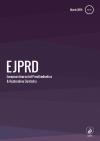European Journal of Prosthodontics and Restorative Dentistry
Fit Accuracy of Pressed and Milled Lithium Disilicate Inlays Fabricated From Conventional Impressions or a Laboratory-Based Digital Workflow
Abstract
European Journal of Prosthodontics and Restorative Dentistry (2019) 27, 18–25
rL
td
Fit Accuracy of Pressed and
Milled Lithium Disilicate
Inlays Fabricated From
Conventional Impressions or
a Laboratory-Based Digital
Workflow
Keywords
rbe
Inlay
Lithium Disilicate
CAD-CAM
ABSTRACT
Authors
Dr. Foudda Homsy *
(DCD, DES, DScO)
Matteo Bottin §
Ba
(BSc)
Prof. Mutlu Özcan ^
(Dr Med Dent, PhD)
Prof. Zeina Majzoub *
Dr. Foudda Homsy *
Email: [email protected]
nn
Address for Correspondence
is
(DCD, DMD, MScDd)
* Lebanese University, Faculty of Dental Medicine
Biesse Dental Srl, Montà , PD, Italy
§
Purpose: The impact of material on the adaptation of lithium disilicate inlays is poorly
documented. This in vitro study aims at comparing the fit accuracy of pressed and
milled inlays obtained from conventional impression and laboratory-based computeraided design and computer-aided manufacturing. Material and Methods: A typodont
molar was prepared for a mesio-occlusal ceramic inlay. The stone die generated from
one conventional impression was scanned once using a laboratory scanner and the
same design was used to produce 15 pressed lithium disilicate inlays from milled wax
patterns (group CIDW), and 15 inlays from lithium disilicate blanks (group CICAD) with
a 5-axis milling machine. Marginal and internal discrepancies were measured using the
replica technique. Mixed-model ANOVA was applied to assess differences according to
material and gap location at P<0.05. Results: Material and discrepancy location had a
significant effect on fit measurements. Group CIDW showed significantly smaller marginal (37.4 µm) and internal (69.2 µm) discrepancies than group CICAD (59.6 µm and
93.7 µm respectively). Marginal discrepancies were significantly smaller than internal
discrepancies within both groups. Conclusions: Pressed inlays generated from conventional impression and milled wax patterns yielded better fit accuracy than milled inlays
obtained from conventional impression and subtractive manufacturing.
©
De
^ University of Zurich, Dental Materials Unit
Received: 13.06.18
Accepted: 11.01.19
doi: 10.1922/EJPRD_01828Homsy08
INTRODUCTION
Metal-free restorations are increasingly being incorporated into prosthodontic rehabilitations as a result of greater esthetic demands. Among
ceramic materials, lithium disilicate glass ceramics are widely used in the
fabrication of tooth- and implant-supported prostheses because of their
excellent esthetic and mechanical properties.1 Lithium disilicate restorations can be made by using either lost-wax hot pressing techniques or
computer-aided-designed and computer-aided-manufacturing (CAD/CAM)
digital milling of monolithic blocks.2
Pressed restorations are usually produced by burning out wax patterns
that are conventionally shaped by laboratory technicians from conventional
impressions. The wax patterns can also be produced by milling wax blocks
• • • • • • • • • • • • • • • • • • • • • • • • • • • • • • • •
ejprd.org - Published by Dennis Barber Journals.
EJPRD
Copyright ©2019 by Dennis Barber Ltd. All rights reserved.
Authors
Dr. Foudda Homsy, Matteo Bottin, Prof. Mutlu Özcan, Prof. Zeina Majzoub
Articles from this issue
| Title / DOI | Access | Page Start | Page End | Purchase |
|---|---|---|---|---|
| The Effects of Colored Pigments on the Translucency of Experimental Dental Resin Composites 10.1922/EJPRD_01855Azhar08 |
|
3 | 9 |
£10.00 |
| Evaluation of Monomer Leaching from Resin Cement Through Dentin 10.1922/EJPRD_01854Kerezoudi08 |
|
10 | 17 |
£10.00 |
| Fit Accuracy of Pressed and Milled Lithium Disilicate Inlays Fabricated From Conventional Impressions or a Laboratory-Based Digital Workflow 10.1922/EJPRD_01828Homsy08 |
|
18 | 25 |
£10.00 |
| Evaluation of the Internal and Marginal Discrepancies of Co-Cr Metal Copings Prepared via CAD/CAM and Conventional Casting 10.1922/EJPRD_01865Dayan06 |
|
26 | 31 |
£10.00 |
| Adequately Prepared? A Study Using an Innovative Computer Application to Measure Clinical Crown Convergence Angles Achieved by Students at a UK Dental School 10.1922/EJPRD_01832Strain07 |
|
32 | 38 |
£10.00 |
| Clinical Performance of Nanofilled and Microhybrid Direct Composite Restorations on Endodontically Treated Teeth 10.1922/EJPRD_01638Akalin09 |
|
39 | 47 |
£10.00 |
 Free Access
Free Access No Access
No Access Full Access
Full Access


